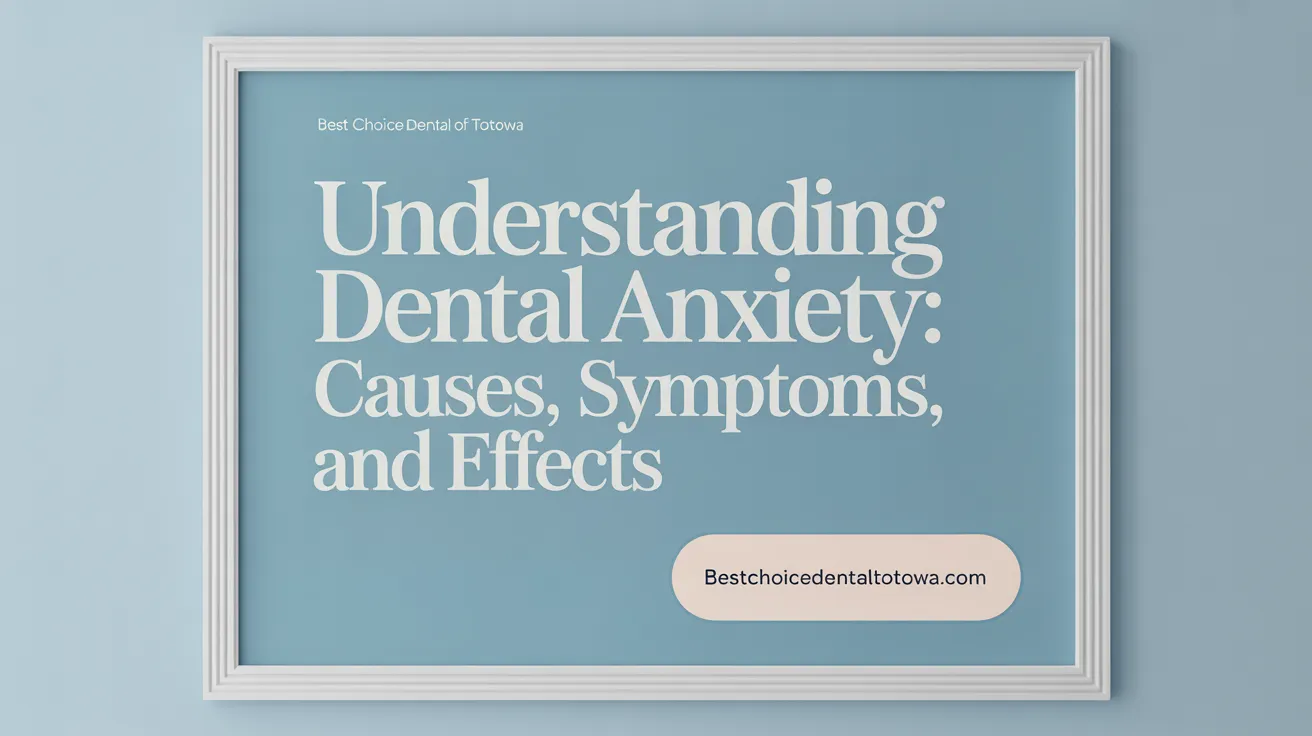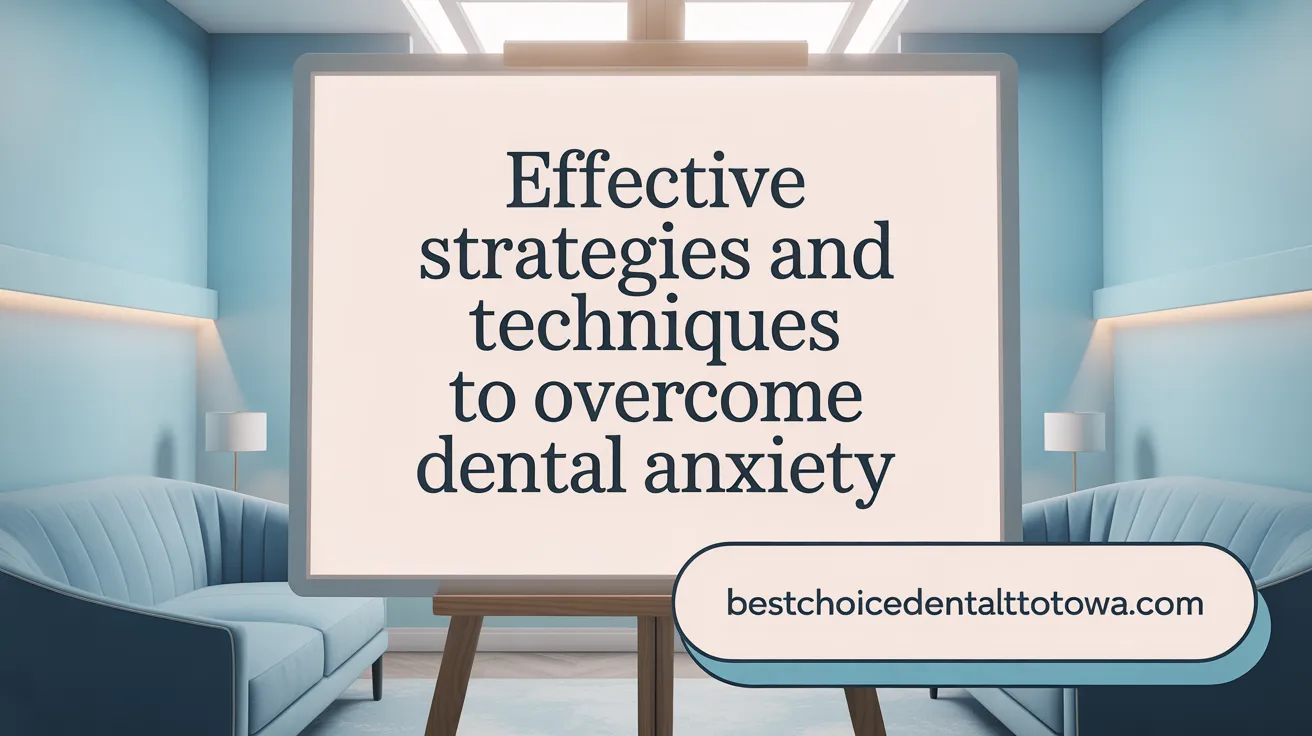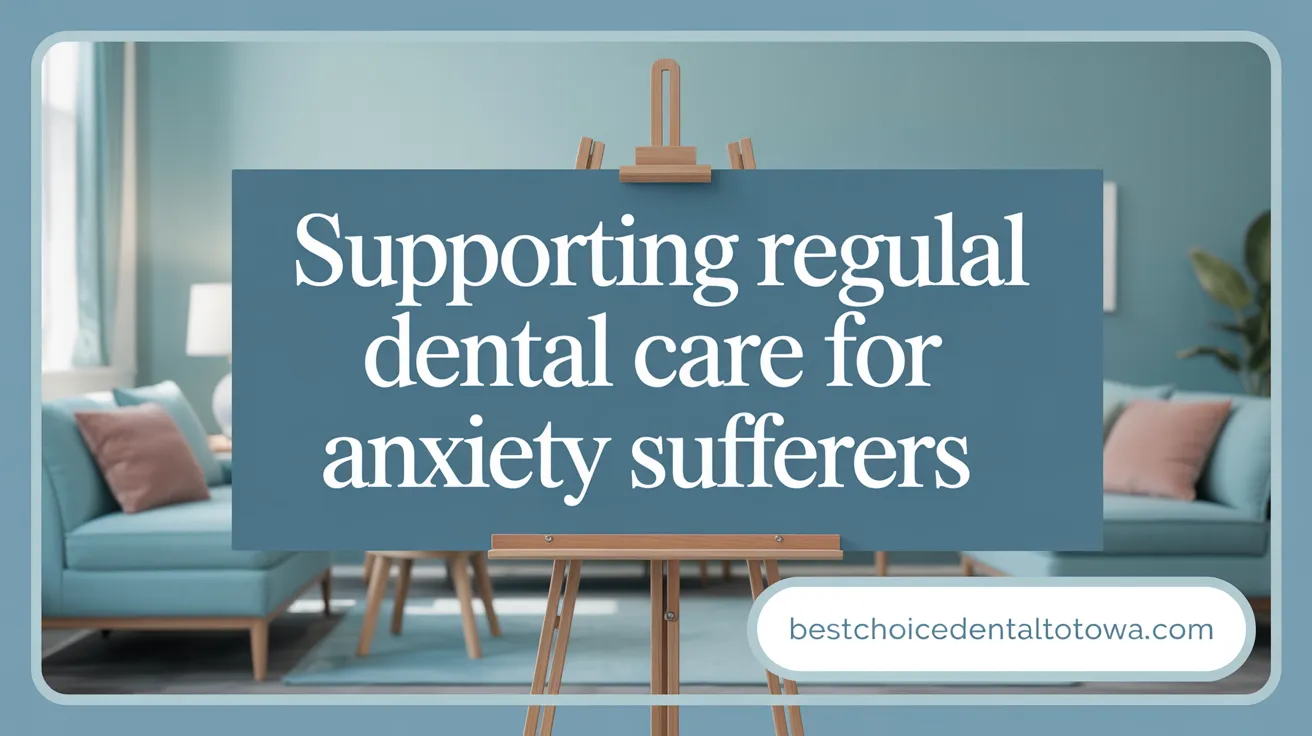Understanding and Overcoming Dental Anxiety
Dental anxiety is a widespread challenge that prevents many individuals from seeking essential oral care. This anxiety stems from various causes, manifests in distinct symptoms, and significantly impacts oral health if left unaddressed. Fortunately, a variety of strategies—ranging from behavioral techniques to sedation—exist to help patients mitigate their fears and make dental visits comfortable and manageable. This article explores dental anxiety in depth and offers practical advice for patients and caregivers to foster calmer, more positive dental experiences.
<!-- VIDEO:eyJsaW5rIjoiaHR0cHM6Ly93d3cueW91dHViZS5jb20vd2F0Y2g/dj0xeUpvVE5NM09yYyIsImltYWdlVXJsIjoiaHR0cHM6Ly9lbmNyeXB0ZWQtdnRibjAuZ3N0YXRpYy5jb20vdmlkZW8/cT10Ym46QU5kOUdjVHB6dHdrZ0hxVkswcmR3N29EV2F6NGJkVnF2empGSExBem5nIiwidGl0bGUiOiJEZW50YWwgQW54aWV0eT8gNSBXYXlzIHRvIE1hbmFnZSBJdCBBdCBZb3VyIE5leHQgVmlzaXQiLCJzbmlwcGV0IjoiQWZyYWlkIG9mIGdvaW5nIHRvIHRoZSBkZW50aXN0PyBCZSBhZnJhaWQgbm8gbW9yZS4gRHIgV2FycmVuIEFudG9ub2ZmIHNoYXJlZCBvbiB0aGlzIHZpZGVvIDUgdGhpbmdzIHlvdSBjYW4gZG8gdG8gaGVscCBtYWtlIHlvdXIgbmV4dCB2aXNpdCB0byJ9 -->Causes, Symptoms, and Effects of Dental Anxiety

What causes dental anxiety and what are its common symptoms and effects?
Dental anxiety is often rooted in negative previous experiences, such as painful procedures or traumatic encounters at the dentist's office. It can also stem from a fear of needles, the sound of dental instruments, or feelings of loss of control during treatment. Some individuals develop anxiety due to embarrassment about their dental health or underlying mental health conditions like generalized anxiety disorder, PTSD, or depression. For more on dental anxiety and phobia and its causes, refer to this overview on dental anxiety.
Symptoms of dental anxiety are both physical and emotional. Common physical signs include an increased heart rate, sweating, trembling, nausea, and feelings of dizziness. Emotional responses may involve distress, crying, irritability, or using humor and aggression as coping mechanisms. Many people also experience anticipatory anxiety, where worry and nervousness increase before the appointment, sometimes affecting sleep. This is detailed further in articles about signs of dental anxiety and psychological responses and recognizing dental anxiety.
This anxiety has significant consequences for dental and overall health. When patients avoid dental visits, dental problems such as cavities, gum disease, and oral infections can worsen. This neglect often leads to more invasive and costly treatments later on and may even impact systemic health, considering the connection between oral health and conditions like diabetes. The importance of regular dental visits and the oral health and overall health connection are key to prevention.
Triggers for dental anxiety include loud noises from dental tools, the sight of needles, being confined in the dental chair, and feeling judged or out of control during procedures. Recognizing these triggers and symptoms is vital for dental professionals to tailor an approach that alleviates fears; for insight on triggers for dental anxiety and managing them, see related resources.
Managing dental anxiety involves establishing trust through effective communication, employing relaxation techniques such as deep breathing or guided imagery, and using pharmacological aids like sedation or anesthesia when necessary. Openly discussing fears with the dentist can significantly improve the experience, encouraging regular visits and better oral health maintenance. Techniques for managing dental anxiety, including relaxation methods, deep breathing, and sedation options are widely recommended.
Strategies and Techniques to Manage Dental Anxiety

What strategies and techniques can help manage and overcome dental anxiety?
Managing dental anxiety effectively often involves multiple strategies tailored to the individual patient. Psychological interventions form a core component, including cognitive-behavioral therapy (CBT), which helps restructure negative thoughts about dental treatment. Relaxation techniques such as deep diaphragmatic breathing, guided imagery, meditation, autogenic relaxation, and mindfulness exercises are proven to lower anxiety levels.
Distraction methods serve as practical tools during dental procedures. Patients might listen to calming music, use stress relief tools like stress balls, or watch videos to divert their attention away from dental instruments and treatments.
Creating a calming office environment is also essential. Using soft lighting, soothing sounds, and maintaining a friendly, supportive staff encourages a sense of safety and control. Open communication about fears, along with establishing signals to pause or stop treatment if overwhelmed, empowers patients and reduces stress.
For severe cases of dental phobia, pharmacological options are often employed. These include sedation methods such as nitrous oxide (laughing gas), oral sedatives, intravenous sedation, or even general anesthesia in extreme cases. Combining psychological techniques with sedation often yields the best outcomes.
Early assessment through questionnaires like the Modified Dental Anxiety Scale (MDAS) or physiological measures such as blood pressure and pulse helps identify anxious patients. This enables dental professionals to plan appropriate management strategies.
Training dental staff in anxiety reduction techniques and familiarizing patients with dental procedures beforehand can diminish fear and foster trust. Ultimately, a comprehensive approach that respects patient comfort and addresses individual fears facilitates continued dental care and improves overall oral and general health.
Preparing for Your Dental Visit: Practical Tips to Reduce Fear and Stress

How can patients prepare for a dental visit to reduce fear and stress?
Patients can take several steps to ease anxiety before a dental appointment. Practicing relaxation techniques such as deep breathing exercises, visualization, or mindfulness can help calm nerves. Arriving early allows time to settle in and reduces feelings of rushing or anticipation. Ensuring they are well-rested and have eaten lightly can prevent discomfort and fatigue.
Open communication with the dentist about any fears, past negative experiences, or specific concerns is crucial. Patients should feel comfortable discussing their fears and establishing signals to pause or stop during treatment if needed, as highlighted in effective communication with the dentist for anxiety management.
Bringing supportive items like headphones with calming music or a stress-relief object can provide comfort. Learning about the procedures expected during the visit in advance helps minimize uncertainty. Focusing on the health benefits and the importance of maintaining oral health can motivate patients to overcome their fears.
By taking these proactive steps, individuals can foster a sense of control and confidence, making their dental visits less stressful and more productive.
Communication and Behavioral Strategies During Dental Visits

Open conversation with dental professionals
Effective communication is vital to reduce dental anxiety. Patients should openly share their fears and concerns with their dentist, which helps in tailoring treatment approaches that make them feel more comfortable. Asking questions about each step of the procedure not only clarifies what to expect but also fosters trust. Dentists can reassure patients by explaining procedures clearly and normalizing feelings of nervousness. This transparent dialogue creates a supportive environment, making it easier for patients to relax (Dental anxiety management).
Use of signals
Establishing signals or cues before treatment begins can empower patients to communicate their comfort level effectively. Common signals include raising a hand to indicate they want a break or feel overwhelmed. This method ensures control, allowing patients to pause or stop treatments if necessary, which can alleviate feelings of helplessness or loss of control (signals to pause dental treatment).
Distraction and relaxation during treatment
Distraction techniques like listening to calming music, audiobooks, or watching videos using headphones can divert attention away from procedures and reduce anxiety. Virtual reality headsets or visual stimuli may also be employed for enhanced distraction. Breathing exercises, such as deep, slow breaths, activate the body's relaxation response (breathing exercises for dental anxiety). These techniques help manage physiological symptoms of anxiety, such as rapid heartbeat or trembling (Distraction techniques for dental anxiety).
Behavioral techniques to enhance control
Behavioral strategies like guided imagery or progressive muscle relaxation teach patients to manage stress. Patients can also use positive reinforcement, rewarding themselves afterward to create positive associations with dental visits. Systematic desensitization involves gradual exposure to dental stimuli in controlled settings, helping patients build tolerance over time (psychotherapeutic behavioral techniques for dental anxiety).
Creating a trusting relationship with the dentist
Trust is foundational in alleviating dental anxiety. Finding a caring, empathetic dentist who listens and validates fears promotes confidence. Consistent, gentle care tailored to patient comfort over multiple visits can strengthen this trust. When patients feel respected and understood, their anxiety diminishes, improving treatment cooperation and overall dental health (Building trust in dental care, Importance of regular dental visits).
Sedation and Medical Options for Dental Anxiety
What sedative and other treatment options are available for patients with dental anxiety?
Managing dental anxiety often requires a combination of behavioral strategies and medicative interventions. Common sedation options include nitrous oxide, oral sedation, IV sedation, and sometimes general anesthesia.
Nitrous oxide, also known as laughing gas, is inhaled through a mask and acts quickly to relax the patient. It allows for a degree of consciousness, meaning patients can respond to commands and are typically able to drive afterward. It is particularly suitable for moderate anxiety or shorter procedures (Managing dental anxiety with sedation).
Oral sedation involves taking a prescribed medication, such as a benzodiazepine, before the appointment. This form of sedation helps induce relaxation or sleepiness, but the patient remains conscious and responsive. It is often used for patients with mild to moderate anxiety and offers greater control over discomfort (Medications for dental anxiety relief).
IV sedation delivers medication directly into the bloodstream, providing deeper sedation where patients are usually less aware of the procedure. It is preferred in cases of severe anxiety or complex treatments, as it minimizes memory of the procedure and alleviates most anxiety. It requires careful monitoring by trained professionals (Intravenous sedation for dental fear).
For especially severe cases or complex surgical procedures, general anesthesia may be employed. Under general anesthesia, the patient is completely unconscious and unaware of the procedure. This method is typically performed in hospital settings and is suitable for patients with extreme dental phobia or those with special needs (General anesthesia in dentistry).
Safety and suitability considerations
Each sedation type carries specific considerations. Nitrous oxide has a high safety profile but may be unsuitable for pregnant women or individuals with certain respiratory issues. Oral sedation requires evaluating liver function and interactions with other medications. IV sedation demands expertise in anesthesia and cardiovascular monitoring. General anesthesia involves risks associated with unconsciousness and requires an anesthesiologist (Safety in sedation dentistry).
Pre-treatment assessments, including medical history review and vital signs evaluation, are vital to determine the most appropriate sedation method. Continuous monitoring during sedation ensures patient safety, with emergency equipment readily available (Continuous monitoring during dental sedation).
Benefits and limitations of each sedation type
- Nitrous oxide: Fast onset, quick recovery, minimal side effects. Limited to moderate anxiety (Benefits of nitrous oxide sedation).
- Oral sedation: Offers relaxed state with minimal invasiveness. Sedation level can vary; some patients may be too anxious or unresponsive (Oral sedation in dentistry).
- IV sedation: Deep relaxation, amnesia, suitable for complex cases. Requires monitoring and trained personnel (IV sedation overview).
- General anesthesia: Complete unconsciousness for extensive procedures. Higher risks and costs; usually reserved for specific cases (When general anesthesia is used in dentistry).
When is sedation recommended?
Sedation options are recommended when behavioral techniques alone are insufficient, especially for severe anxiety, lengthy or invasive procedures, or for patients with special needs. Dentists evaluate each case to balance safety, comfort, and effectiveness (Sedation dentistry indications).
Supporting measures during sedation
Supporting measures include pre-treatment evaluations, patient monitoring throughout the procedure, and post-treatment recovery care. Clear communication about the sedation process, side effects, and aftercare is essential to ensure a safe and positive experience (Communication and monitoring during dental sedation).
Incorporating sedation into dental care requires collaboration between dentists, anesthesiologists, and other healthcare professionals to tailor the approach to each patient’s needs. This ensures that even the most anxious patients receive the necessary treatment without undue stress or discomfort (Collaborative sedation approach).
Maintaining Regular Dental Visits and Support for Dental Anxiety

Why are regular dental visits important and how can they be made more comfortable for anxious patients?
Maintaining routine dental appointments is essential for safeguarding oral health, preventing cavities, gum disease, and detecting issues early, such as oral cancer. Regular visits reduce the need for complex and invasive treatments, which can heighten anxiety. To help anxious patients feel more at ease, dental offices can establish a calming environment with soothing lighting, friendly staff, and a gentle approach.
Implementing relaxation techniques like focused breathing exercises, guided imagery, and distraction methods—such as playing calming music or using virtual reality—can significantly decrease anxiety. Open communication is vital; patients should feel comfortable expressing their fears and past negative experiences. Dentists can then personalize approaches, including offering sedation options like nitrous oxide or oral sedatives, when necessary.
Bringing a support person, scheduling appointments during less busy hours, and making use of distraction tools further enhance comfort. Building trust and giving patients a sense of control during procedures encourages positive perceptions of dental care. These strategies foster regular attendance, which ultimately preserves oral health and reduces future dental fears.
When should professional guidance or assessments be sought for managing dental phobia?
Professional help should be considered when dental anxiety becomes severe, such as in cases of dentophobia, which leads to avoidance of dental care and worsening health outcomes. Indicators include persistent, intense fear lasting over six months, physical symptoms like dizziness, sweating, or rapid heartbeat during dental thoughts or visits, and failure of self-help methods.
Specialists such as dental psychologists or therapists trained in behavioral and cognitive therapies can assist. Techniques like exposure therapy, cognitive-behavioral therapy (CBT), and relaxation training address the root causes of fear and help develop coping strategies.
Seeking early professional support is essential when anxiety impairs treatment attendance or causes significant distress. These interventions improve patients’ confidence and ability to manage fears, ensuring they receive necessary dental treatments and maintain good oral and systemic health.
What educational resources are available to help patients understand and cope with dental fears?
Patients have access to numerous educational tools designed to demystify dental procedures and reduce anxiety. Reputable websites, informational brochures, and dedicated patient education programs within dental practices provide:
- Guides on understanding common dental treatments and sensations
- Techniques for relaxation, including breathing exercises and guided imagery
- Information on sedation options and their safety
- Tips for effective communication with dental staff
Scholarly resources and online courses from institutions like Temple University offer deeper insights into managing dental fear through exposure, cognitive restructuring, and coping skills.
Assessment questionnaires such as the Modified Dental Anxiety Scale (MDAS) assist individuals in identifying their anxiety levels. Empowered with knowledge, patients can actively participate in their care, making visits more comfortable and fostering trust.
How can parents and caregivers support children and adults in reducing dental anxiety?
Support from parents and caregivers is fundamental in easing dental fears. Strategies include creating a positive, supportive environment with calm spoken explanations and predictable routines.
Use age-appropriate language to explain procedures and employ techniques like the tell-show-do method, which demonstrates what will happen beforehand. Incorporating small distractions, such as music or stress balls, can divert attention during treatment.
Gradual exposure—starting with initial visits that focus on getting comfortable in the environment—builds familiarity and trust. Reinforcing positive behaviors with praise and rewards further motivates cooperation.
Allowing patients to have control, such as using signals to pause treatment, enhances feelings of safety. When appropriate, involving supportive persons or using sedation under professional supervision can provide additional comfort.
By fostering open dialogue, patience, and understanding, caregivers help children and adults feel more secure, increasing the likelihood of regular dental care and improving overall health outcomes.
Encouraging Confidence and Comfort in Dental Care
Dental anxiety is a common barrier to maintaining oral health, but with understanding and the right approaches, it can be effectively managed. Through knowledge of its causes and symptoms, personalized strategies—including relaxation, communication, behavioral techniques, sedation, and professional guidance—patients can overcome fear and make dental visits more comfortable. Supporting patients of all ages with education and empathy fosters trust, reduces anxiety, and promotes regular dental care. By embracing these tools and working collaboratively with dental professionals, individuals can ensure their dental health is safeguarded with confidence and ease.
